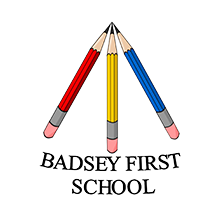Art
At Badsey First School, we believe that art is a vital and integral part of children’s education. It provides our children with opportunities to share and express their individual creativity, building independence, well-being and self-reflection. In doing so, promoting a life-long love of art.
We teach a progressive knowledge and skills-based art curriculum with opportunities to practise and develop mastery in the key processes of art: drawing, painting, printing, textiles and sculpture. At Badsey First School children will therefore understand the visual elements of art and design and be able to use specialised art vocabulary when discussing art pieces. This is supported through the study and critique of key artists from different cultures and periods throughout history, including modern day and local artists.
Through art enrichment opportunities, our children are able to make a positive contribution to the wider community, with our pupil’s artwork proudly displayed in our school art gallery events and in local settings such as the annual village flower festival, and further afield as part of the collaborative GLA additionality offer.
At Badsey First School, we want our children to have high aspirations in art. Staff nurture curiosity, creativity and self-expression alongside resilience, confidence and critical thinking so that pupils understand they are all artists without limitations.
Primary National Curriculum for Art and Design in England
Discover more about our Art Curriculum at Badsey from the documents below:
Art Overview and Progression Document
Art and Design in the Early Years
In the Early Years, like with learning to write, we approach Art and Design first and foremost by ensuring our children develop sound fine and gross motor skills. Activities designed to strengthen grip and practice moving, handling and control skills give children a great foundation from which they can develop skills such as drawing, painting and sculpting. Children in Reception are encouraged to use their imagination and create with different materials as part of the Expressive Art & Design Early Learning Goal.
Art and Design in Key Stage 1 (Years 1 and 2)
The content of art and design teaching and learning is set out in the 2014 National Curriculum for primary schools in England. Pupils should be given opportunities to use a range of materials creatively to design and make products through drawing, painting and sculpture. They explore different techniques in using colour, pattern, texture, line, shape, form and space.
Another important aspect of the art and design curriculum is learning about the work of a range of artists, craft makers and designers, describing the differences and similarities between different practices and disciplines, and making links to their own work.
Art and Design in Key Stage 2 (Years 3, 4 and 5)
The content of the art and design curriculum in Key Stage 2 builds on what children have learned in Key Stage 1. Children should develop and improve their skills in drawing, painting and sculpture using a range of different materials. They are expected to create sketch books to record their learning and to use them to review and revisit ideas. They continue to learn about great artists, architects and designers in history.
Parent Advisory Group quote 2022: Teaching Art inspires freedom, cultural awareness and the importance of different art around the world. Art should be about expressions where there are no borders.
Supporting Your Child at Home
Get Messy!
Try to get hold of as many different types of drawing and painting resources as you can to let your child get creative and explore creating art using different materials. Paints, chalk, crayons, pens, pencils, modelling clay and much more can be found in discount shops. Just don’t forget to put lots of newspaper down first!
Use household object creatively
Alternatively, instead of buying materials, let them get creative using things around the house – for example, pasta and pulses to create pictures using glue.
Keep a sketch book
Encourage your child to keep a sketch book. Suggest that they take it with them when they go out so that they can look for things to sketch – a tree, a building, a scene. Alternatively, if they see something they would like to draw, take a photo on your phone and let them sketch from it when they are home.
Celebrate your child's art
Praise your child’s creations and encourage them not to get disheartened if they feel they have made ‘mistakes’. Explain that art is about being creative and trying out different things. There is no right or wrong way to do things. You could even ‘frame’ their work using coloured paper or card and create a little gallery on the kitchen wall or in their bedroom to display their work.
Discuss and enjoy art together
Find out about local art galleries or museums that you can visit with your child. Encourage them to talk about what they see and to share their opinions – about subject matter, colours, what materials the artist used, and so on.






